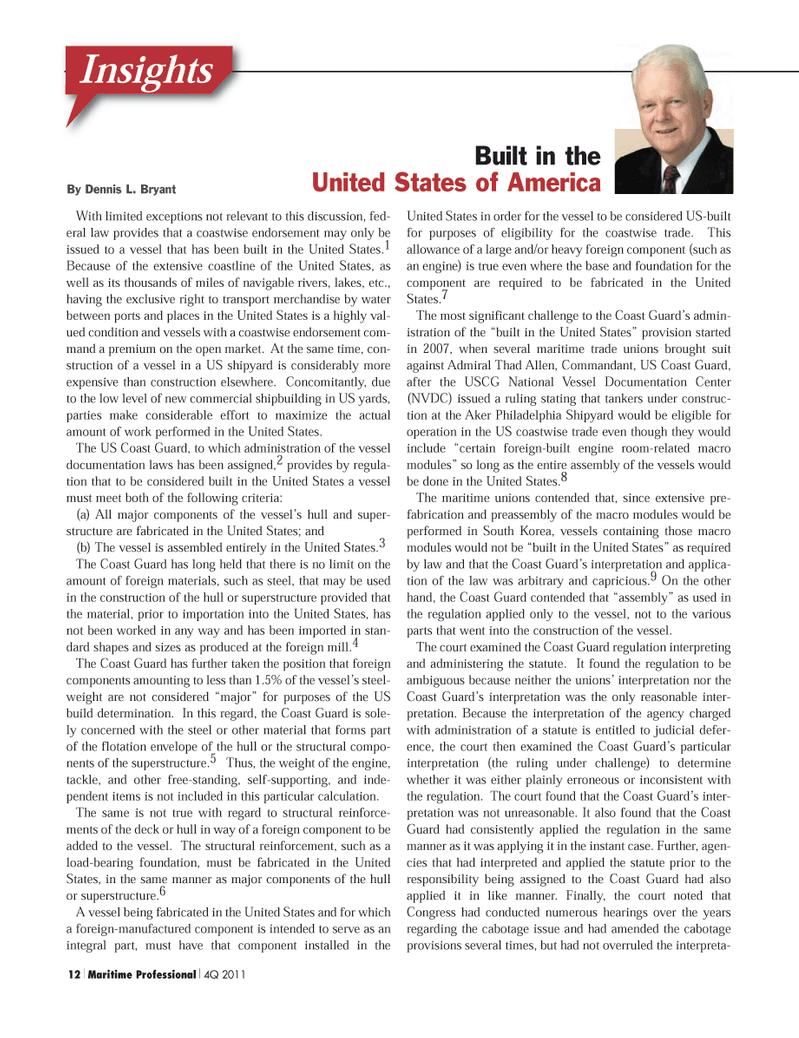
Page 12: of Maritime Logistics Professional Magazine (Q4 2011)
Classification
Read this page in Pdf, Flash or Html5 edition of Q4 2011 Maritime Logistics Professional Magazine
12 Maritime Professional 4Q 2011With limited exceptions not relevant to this discussion, fed- eral law provides that a coastwise endorsement may only be issued to a vessel that has been built in the United States. 1Because of the extensive coastline of the United States, as well as its thousands of miles of navigable rivers, lakes, etc., having the exclusive right to transport merchandise by water between ports and places in the United States is a highly val- ued condition and vessels with a coastwise endorsement com- mand a premium on the open market. At the same time, con- struction of a vessel in a US shipyard is considerably more expensive than construction elsewhere. Concomitantly, due to the low level of new commercial shipbuilding in US yards, parties make considerable effort to maximize the actual amount of work performed in the United States. The US Coast Guard, to which administration of the vessel documentation laws has been assigned, 2provides by regula- tion that to be considered built in the United States a vessel must meet both of the following criteria: (a) All major components of the vessel?s hull and super- structure are fabricated in the United States; and (b) The vessel is assembled entirely in the United States. 3 The Coast Guard has long held that there is no limit on theamount of foreign materials, such as steel, that may be usedin the construction of the hull or superstructure provided that the material, prior to importation into the United States, hasnot been worked in any way and has been imported in stan- dard shapes and sizes as produced at the foreign mill.4The Coast Guard has further taken the position that foreign components amounting to less than 1.5% of the vessel?s steel- weight are not considered ?major? for purposes of the USbuild determination. In this regard, the Coast Guard is sole- ly concerned with the steel or other material that forms partof the flotation envelope of the hull or the structural compo- nents of the superstructure.5Thus, the weight of the engine,tackle, and other free-standing, self-supporting, and inde-pendent items is not included in this particular calculation.The same is not true with regard to structural reinforce- ments of the deck or hull in way of a foreign component to be added to the vessel. The structural reinforcement, such as a load-bearing foundation, must be fabricated in the United States, in the same manner as major components of the hullor superstructure.6A vessel being fabricated in the United States and for which a foreign-manufactured component is intended to serve as an integral part, must have that component installed in the United States in order for the vessel to be considered US-built for purposes of eligibility for the coastwise trade. This allowance of a large and/or heavy foreign component (such as an engine) is true even where the base and foundation for the component are required to be fabricated in the United States.7The most significant challenge to the Coast Guard?s admin- istration of the ?built in the United States? provision started in 2007, when several maritime trade unions brought suit against Admiral Thad Allen, Commandant, US Coast Guard, after the USCG National Vessel Documentation Center (NVDC) issued a ruling stating that tankers under construc- tion at the Aker Philadelphia Shipyard would be eligible for operation in the US coastwise trade even though they would include ?certain foreign-built engine room-related macro modules? so long as the entire assembly of the vessels would be done in the United States.8 The maritime unions contended that, since extensive pre- fabrication and preassembly of the macro modules would be performed in South Korea, vessels containing those macro modules would not be ?built in the United States? as required by law and that the Coast Guard?s interpretation and applica- tion of the law was arbitrary and capricious. 9On the otherhand, the Coast Guard contended that ?assembly? as used inthe regulation applied only to the vessel, not to the various parts that went into the construction of the vessel. The court examined the Coast Guard regulation interpreting and administering the statute. It found the regulation to be ambiguous because neither the unions? interpretation nor the Coast Guard?s interpretation was the only reasonable inter- pretation. Because the interpretation of the agency charged with administration of a statute is entitled to judicial defer-ence, the court then examined the Coast Guard?s particular interpretation (the ruling under challenge) to determinewhether it was either plainly erroneous or inconsistent with the regulation. The court found that the Coast Guard?s inter- pretation was not unreasonable. It also found that the Coast Guard had consistently applied the regulation in the same manner as it was applying it in the instant case. Further, agen- cies that had interpreted and applied the statute prior to theresponsibility being assigned to the Coast Guard had alsoapplied it in like manner. Finally, the court noted that Congress had conducted numerous hearings over the years regarding the cabotage issue and had amended the cabotage provisions several times, but had not overruled the interpreta- Built in theUnited States of AmericaBy Dennis L. BryantInsightsMP #4 (1-17):MP Layouts 11/7/2011 4:38 PM Page 12

 11
11

 13
13
